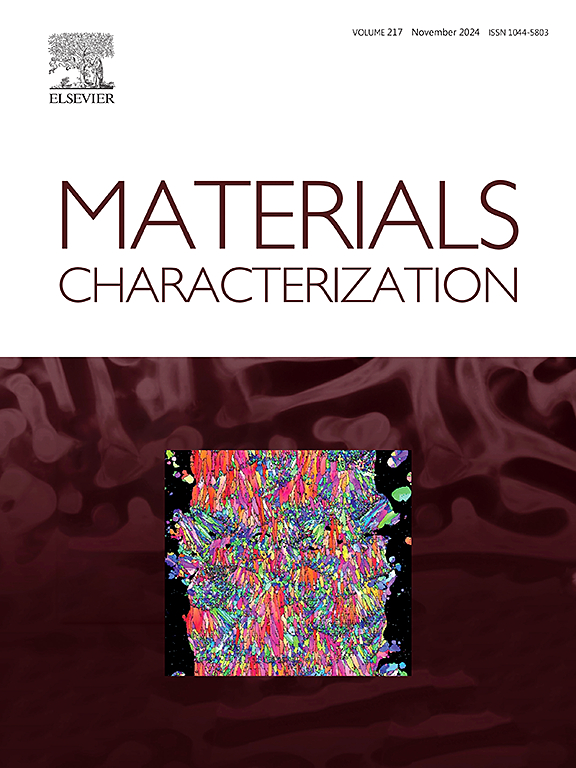C/B ratio-driven phase modulation in stainless steel coating: A synergistic strategy for corrosion and wear performance optimization
IF 4.8
2区 材料科学
Q1 MATERIALS SCIENCE, CHARACTERIZATION & TESTING
引用次数: 0
Abstract
The development of stainless steel coatings confronts an intrinsic trade-off between mechanical durability and corrosion resistance under extreme service conditions. Although carbon strengthens materials via carbide precipitation, this mechanism carries significant risks of introducing galvanic corrosion. Current scientific understanding remains incomplete regarding the optimal hard-phase design that simultaneously maximizes hardness and corrosion integrity in stainless systems. This study systematically investigated the influence of C/B ratio on microstructural evolution, corrosion resistance, and wear performance in modified stainless steel coatings. Four coatings with varying C/B ratios (0.8C + 0.2B, 0.5C + 0.5B, 0.2C + 0.8B, and 1.0B) were fabricated via laser cladding. Microstructural characterization revealed progressive phase transformations: austenite-dominated → martensite-dominated → ferrite-martensite dual-phase systems, accompanied by sequential reinforcement phase transitions from M23C6-type carboborides to M3C-type carboborides and finally to M2B borides. Notably, the 0.2C + 0.8B coating exhibited peak hardness (654 HV0.5) and the strongest wear resistance by virtue of the superior elastic-plastic deformation resistance of the matrix coupled with the high hardness and modulus of M3(C, B). Concurrently, this composition demonstrated secondary corrosion resistance due to the smallest volta potential difference (the minimum corrosion driving force) between the matrix and M3(C, B). These findings attest to the application potential of the M3C-type reinforcement + martensite matrix in the field of corrosion and wear, and providing guidelines for designing advanced stainless steels with tailored properties.
不锈钢涂层中C/B比驱动的相位调制:一种优化腐蚀和磨损性能的协同策略
不锈钢涂层的发展面临着在极端使用条件下机械耐久性和耐腐蚀性之间的内在权衡。虽然碳通过碳化物沉淀强化材料,但这种机制存在引入电偶腐蚀的重大风险。目前的科学理解仍然不完整的最佳硬相设计,同时最大限度地提高不锈钢系统的硬度和腐蚀完整性。本研究系统地研究了C/B比对改性不锈钢涂层组织演变、耐蚀性和磨损性能的影响。采用激光熔覆法制备了C/B比分别为0.8C + 0.2B、0.5C + 0.5B、0.2C + 0.8B和1.0B的4种涂层。显微组织表征显示出奥氏体为主→马氏体为主→铁素体-马氏体双相体系的递进相变,伴随着从m23c6型碳化物到m3c型碳化物再到M2B型碳化物的强化相变。值得注意的是,由于基体具有优异的弹塑性变形抗力,加上M3的高硬度和模量,0.2C + 0.8B涂层的硬度峰值为654 HV0.5,耐磨性最强(C, B)。同时,由于基体与M3之间的伏特电位差(最小腐蚀驱动力)最小,该成分表现出二次耐腐蚀性(C, B)。这些发现证明了m3c型增强体+马氏体基体在腐蚀和磨损领域的应用潜力,并为设计具有定制性能的先进不锈钢提供了指导。
本文章由计算机程序翻译,如有差异,请以英文原文为准。
求助全文
约1分钟内获得全文
求助全文
来源期刊

Materials Characterization
工程技术-材料科学:表征与测试
CiteScore
7.60
自引率
8.50%
发文量
746
审稿时长
36 days
期刊介绍:
Materials Characterization features original articles and state-of-the-art reviews on theoretical and practical aspects of the structure and behaviour of materials.
The Journal focuses on all characterization techniques, including all forms of microscopy (light, electron, acoustic, etc.,) and analysis (especially microanalysis and surface analytical techniques). Developments in both this wide range of techniques and their application to the quantification of the microstructure of materials are essential facets of the Journal.
The Journal provides the Materials Scientist/Engineer with up-to-date information on many types of materials with an underlying theme of explaining the behavior of materials using novel approaches. Materials covered by the journal include:
Metals & Alloys
Ceramics
Nanomaterials
Biomedical materials
Optical materials
Composites
Natural Materials.
 求助内容:
求助内容: 应助结果提醒方式:
应助结果提醒方式:


